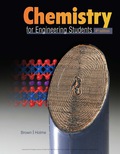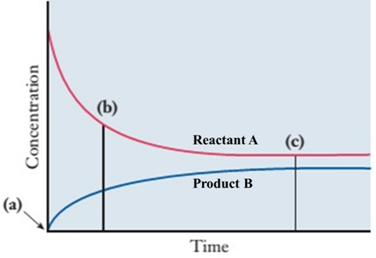
EBK CHEMISTRY FOR ENGINEERING STUDENTS,
4th Edition
ISBN: 9781337671439
Author: Holme
Publisher: CENGAGE LEARNING - CONSIGNMENT
expand_more
expand_more
format_list_bulleted
Question
Chapter 12, Problem 12.87PAE
Interpretation Introduction
To determine:
The label of two lines i.e. blue line and red line and the state of the reactions in terms of reactant or product with respect of time (a), (b) and (c).
 |
Expert Solution & Answer
Want to see the full answer?
Check out a sample textbook solution
Students have asked these similar questions
Draw the product formed when the following pair of compounds is treated with NaOEt in ethanol.
+
i
CN
I need help with the following
Explain the reasons for the color changes that occur when the gel and the solution examined dry.
Chapter 12 Solutions
EBK CHEMISTRY FOR ENGINEERING STUDENTS,
Ch. 12 - list chemical reactions important in the...Ch. 12 - Explain that equilibrium is dynamic, and that at...Ch. 12 - Prob. 3COCh. 12 - calculate equilibrium constants from experimental...Ch. 12 - Prob. 5COCh. 12 - calculate molar solubility from Kspor vice versa.Ch. 12 - Prob. 7COCh. 12 - Prob. 8COCh. 12 - calculate the new equilibrium composition of a...Ch. 12 - Explain the importance of both kinetic and...
Ch. 12 - Identify the first chemical step in the production...Ch. 12 - Explain why the hydration process for concrete is...Ch. 12 - Prob. 12.3PAECh. 12 - 12.4 In what geographical region of the country...Ch. 12 - Prob. 12.5PAECh. 12 - Prob. 12.6PAECh. 12 - Prob. 12.7PAECh. 12 - On your desk is a glass half-filled with water and...Ch. 12 - An equilibrium involving the carbonate and...Ch. 12 - A small quantity of a soluble salt is placed in...Ch. 12 - Prob. 12.11PAECh. 12 - Prob. 12.12PAECh. 12 - Write equilibrium (mass action) expressions for...Ch. 12 - What is the difference between homogeneous...Ch. 12 - Write equilibrium expressions for each of the...Ch. 12 - Write equilibrium expressions for each of the...Ch. 12 - 12.17 Which of the following is more likely to...Ch. 12 - The reaction, 3 H2(g) + N2(g) (g), has the fol...Ch. 12 - 12.19 For each of the following equations, write...Ch. 12 - Consider the following equilibria involving SO2(g)...Ch. 12 - Prob. 12.21PAECh. 12 - Prob. 12.22PAECh. 12 - Prob. 12.23PAECh. 12 - Prob. 12.24PAECh. 12 - Prob. 12.25PAECh. 12 - The following data were collected for the...Ch. 12 - The following data were collected for a system at...Ch. 12 - Prob. 12.28PAECh. 12 - Nitrosyl chloride, NOCI, decomposes to NO and Cl,...Ch. 12 - Hydrogen gas and iodine gas react via the...Ch. 12 - 12.31 A system consisting of 0.100 mole of oxygen...Ch. 12 - Prob. 12.32PAECh. 12 - Prob. 12.33PAECh. 12 - 1’he reaction in Exercise 12.33 was repeated. This...Ch. 12 - In the reaction in Exercise 12.33, another trial...Ch. 12 - The experiment in Exercise 12.33 was redesigned so...Ch. 12 - Again the experiment in Exercise 12.33 was...Ch. 12 - At a particular temperature, the equilibrium...Ch. 12 - A student is simulating the carbonic acid—hydrogen...Ch. 12 - Because carbonic acid undergoes a second...Ch. 12 - Because calcium carbonate is a sink for CO32- in a...Ch. 12 - 12.42 The following reaction is in equilibrium in...Ch. 12 - Prob. 12.43PAECh. 12 - Prob. 12.44PAECh. 12 - The following equilibrium is established in a...Ch. 12 - Write the K_, expression for each of the following...Ch. 12 - Prob. 12.47PAECh. 12 - calculate the molar solubility of the following...Ch. 12 - 12.49 The Safe Drinking Water Act of 1974...Ch. 12 - In Exercise 12.49, what is the allowed...Ch. 12 - Prob. 12.51PAECh. 12 - Because barium sulfate is opaque to X-rays, it is...Ch. 12 - The ore cinnabar (HgS) is an important source of...Ch. 12 - Prob. 12.54PAECh. 12 - From the solubility data given for the following...Ch. 12 - The solubility of magnesium fluoride, MgF2, in...Ch. 12 - Solid Na2SO4 is added slowly to a solution that is...Ch. 12 - Will a precipitate of Mg(OH)2 form when 25.0 mL of...Ch. 12 - Use the web to look up boiler scale and explain...Ch. 12 - Prob. 12.60PAECh. 12 - Prob. 12.61PAECh. 12 - 12.62 Write the formula of the conjugate acid of...Ch. 12 - 12.63 For each of the following reactions,...Ch. 12 - What are the products of each of the following...Ch. 12 - Prob. 12.65PAECh. 12 - Prob. 12.66PAECh. 12 - 12.67 Hydrofluoric acid is a weak acid used in the...Ch. 12 - The pH of a 0.129 M solution of a weak acid, HB,...Ch. 12 - Calculate the pH of a 0.10 M solution of propanoic...Ch. 12 - Find the pH of a 0.115 M solution of NH3(aq).Ch. 12 - Acrylic acid is used in the polymer industry in...Ch. 12 - Prob. 12.72PAECh. 12 - Prob. 12.73PAECh. 12 - Prob. 12.74PAECh. 12 - Cyanic acid (HOCN) is a weak acid with AL, = 3.5 X...Ch. 12 - In a particular experiment, the equilibrium...Ch. 12 - Prob. 12.77PAECh. 12 - Prob. 12.78PAECh. 12 - Prob. 12.79PAECh. 12 - Prob. 12.80PAECh. 12 - Prob. 12.81PAECh. 12 - Prob. 12.82PAECh. 12 - Prob. 12.83PAECh. 12 - Prob. 12.84PAECh. 12 - 12.85 In the figure, orange fish are placed in one...Ch. 12 - For the system in the preceding problem, show the...Ch. 12 - Prob. 12.87PAECh. 12 - Which of the following is more likely to...Ch. 12 - Prob. 12.89PAECh. 12 - Prob. 12.90PAECh. 12 - In the following equilibrium in a closed system,...Ch. 12 - Consider the following system:...Ch. 12 - The decomposition of NH4HS , NH4HS(s)NH3(g)+H2S(g)...Ch. 12 - You are designing a process to remove carbonate...Ch. 12 - Equal amounts of two gases, A and B3, are placed...Ch. 12 - Prob. 12.96PAECh. 12 - Prob. 12.97PAECh. 12 - Prob. 12.98PAECh. 12 - Solid CaCO3 ; is placed in a closed container and...Ch. 12 - 12.100 A reaction important in smog formation is...Ch. 12 - 12.101 An engineer working on a design to extract...Ch. 12 - 12.102 A chemical engineer is working to optimize...Ch. 12 - 12.103 Methanol, CH3OH, can be produced by the...Ch. 12 - Prob. 12.104PAECh. 12 - 12.105 Using the kinetic-molecular theory, explain...Ch. 12 - 12.106 The solubility of KCl is 34.7 g per 100 g...Ch. 12 - Prob. 12.107PAECh. 12 - 12.108 A nuclear engineer is considering the...Ch. 12 - 12.109 Copper(II) iodate has a solubility of 0.136...Ch. 12 - 12.110 In Exercise 12.109, what do you predict...Ch. 12 - 12.111 You have three white solids. What...Ch. 12 - Prob. 12.112PAECh. 12 - Prob. 12.113PAECh. 12 - Prob. 12.114PAECh. 12 - Prob. 12.115PAECh. 12 - Prob. 12.116PAECh. 12 - 12.117 The vapor pressure of water at 80.0 °C is...Ch. 12 - Prob. 12.118PAE
Knowledge Booster
Similar questions
- For Raman spectroscopy/imaging, which statement is not true regarding its disadvantages? a) Limited spatial resolution. b) Short integration time. c) A one-dimensional technique. d) Weak signal, only 1 in 108 incident photons is Raman scattered. e) Fluorescence interference.arrow_forwardUsing a cell of known pathlength b = 1.25115 x 10-3 cm, a water absorption spectrum was measured. The band at 1645 cm-1, assigned to the O-H bending, showed an absorbance, A, of 1.40. a) Assuming that water density is 1.00 g/mL, calculate the water molar concentration c (hint: M= mole/L) b) Calculate the molar absorptivity, a, of the 1645 cm-1 band c) The transmitted light, I, can be written as I= Ioexp(-xb), where x is the absorption coefficient (sometimes designated as alpha), Io is the input light, and b is the cell pathlength. Prove that x= (ln10)*x*c. (Please provide a full derivation of the equation for x from the equation for I). d) Calculate x for the 1645 cm-1 bandarrow_forwardI need help with the follloaingarrow_forward
- For a CARS experiment on a Raman band 918 cm-1, if omega1= 1280 nm, calculate the omega2 in wavelength (nm) and the CARS output in wavelength (nm).arrow_forwardI need help with the following questionarrow_forwardFor CARS, which statement is not true regarding its advantages? a) Contrast signal based on vibrational characteristics, no need for fluorescent tagging. b) Stronger signals than spontaneous Raman. c) Suffers from fluorescence interference, because CARS signal is at high frequency. d) Faster, more efficient imaging for real-time analysis. e) Higher resolution than spontaneous Raman microscopy.arrow_forward
- Draw the major product of the Claisen condensation reaction between two molecules of this ester. Ignore inorganic byproducts. Incorrect, 5 attempts remaining 1. NaOCH3/CH3OH 2. Acidic workup Select to Draw O Incorrect, 5 attempts remaining The total number of carbons in the parent chain is incorrect. Review the reaction conditions including starting materials and/or intermediate structures and recount the number of carbon atoms in the parent chain of your structure. OKarrow_forwardUsing a cell of known pathlength b = 1.25115 x 10-3 cm, a water absorption spectrum was measured. The band at 1645 cm-1, assigned to the O-H bending, showed an absorbance, A, of 1.40. a) Assuming that water density is 1.00 g/mL, calculate the water molar concentration c (hint: M= mole/L) b) Calculate the molar absorptivity, a, of the 1645 cm-1 band c) The transmitted light, I, can be written as I= Ioexp(-xb), where x is the absorption coefficient (sometimes designated as alpha), Io is the input light, and b is the cell pathlength. Prove that x= (ln10)*x*c d) Calculate x for the 1645 cm-1 bandarrow_forwardConvert 1.38 eV into wavelength (nm) and wavenumber (cm-1) (c = 2.998 x 108 m/s; h = 6.626 x 10-34 J*s).arrow_forward
arrow_back_ios
SEE MORE QUESTIONS
arrow_forward_ios
Recommended textbooks for you
 ChemistryChemistryISBN:9781305957404Author:Steven S. Zumdahl, Susan A. Zumdahl, Donald J. DeCostePublisher:Cengage Learning
ChemistryChemistryISBN:9781305957404Author:Steven S. Zumdahl, Susan A. Zumdahl, Donald J. DeCostePublisher:Cengage Learning ChemistryChemistryISBN:9781259911156Author:Raymond Chang Dr., Jason Overby ProfessorPublisher:McGraw-Hill Education
ChemistryChemistryISBN:9781259911156Author:Raymond Chang Dr., Jason Overby ProfessorPublisher:McGraw-Hill Education Principles of Instrumental AnalysisChemistryISBN:9781305577213Author:Douglas A. Skoog, F. James Holler, Stanley R. CrouchPublisher:Cengage Learning
Principles of Instrumental AnalysisChemistryISBN:9781305577213Author:Douglas A. Skoog, F. James Holler, Stanley R. CrouchPublisher:Cengage Learning Organic ChemistryChemistryISBN:9780078021558Author:Janice Gorzynski Smith Dr.Publisher:McGraw-Hill Education
Organic ChemistryChemistryISBN:9780078021558Author:Janice Gorzynski Smith Dr.Publisher:McGraw-Hill Education Chemistry: Principles and ReactionsChemistryISBN:9781305079373Author:William L. Masterton, Cecile N. HurleyPublisher:Cengage Learning
Chemistry: Principles and ReactionsChemistryISBN:9781305079373Author:William L. Masterton, Cecile N. HurleyPublisher:Cengage Learning Elementary Principles of Chemical Processes, Bind...ChemistryISBN:9781118431221Author:Richard M. Felder, Ronald W. Rousseau, Lisa G. BullardPublisher:WILEY
Elementary Principles of Chemical Processes, Bind...ChemistryISBN:9781118431221Author:Richard M. Felder, Ronald W. Rousseau, Lisa G. BullardPublisher:WILEY

Chemistry
Chemistry
ISBN:9781305957404
Author:Steven S. Zumdahl, Susan A. Zumdahl, Donald J. DeCoste
Publisher:Cengage Learning

Chemistry
Chemistry
ISBN:9781259911156
Author:Raymond Chang Dr., Jason Overby Professor
Publisher:McGraw-Hill Education

Principles of Instrumental Analysis
Chemistry
ISBN:9781305577213
Author:Douglas A. Skoog, F. James Holler, Stanley R. Crouch
Publisher:Cengage Learning

Organic Chemistry
Chemistry
ISBN:9780078021558
Author:Janice Gorzynski Smith Dr.
Publisher:McGraw-Hill Education

Chemistry: Principles and Reactions
Chemistry
ISBN:9781305079373
Author:William L. Masterton, Cecile N. Hurley
Publisher:Cengage Learning

Elementary Principles of Chemical Processes, Bind...
Chemistry
ISBN:9781118431221
Author:Richard M. Felder, Ronald W. Rousseau, Lisa G. Bullard
Publisher:WILEY